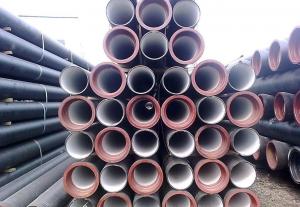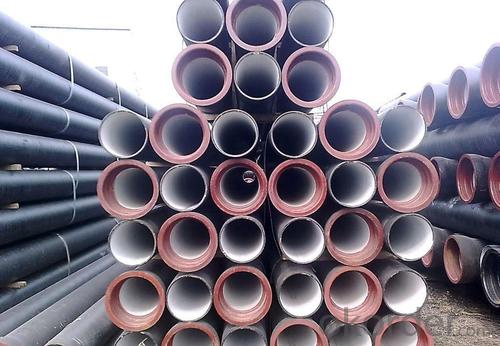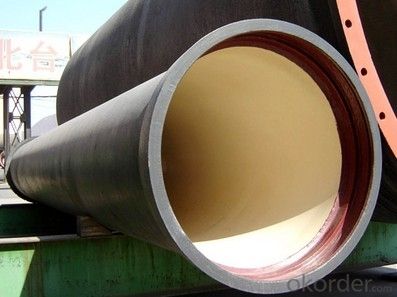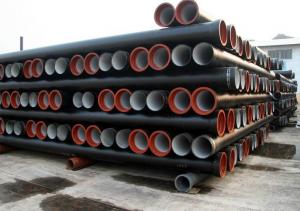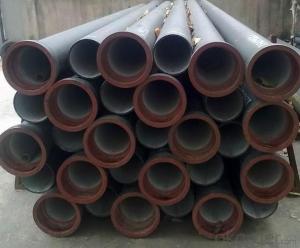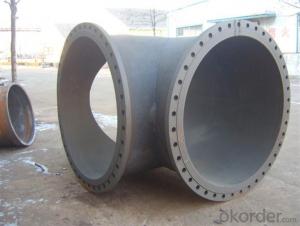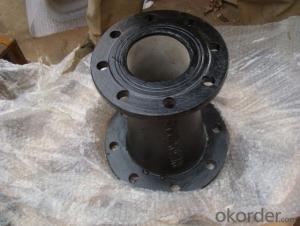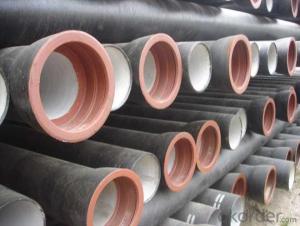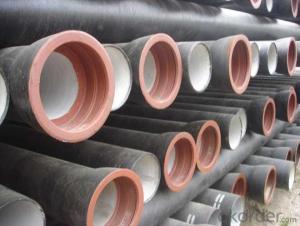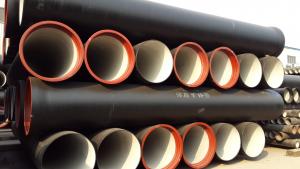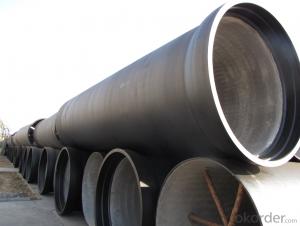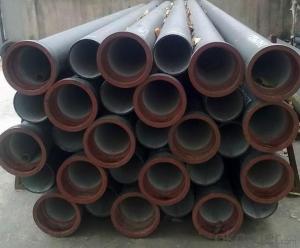Ductile Iron Pipe EN545/EN598 DN800 High Quality
- Loading Port:
- China main port
- Payment Terms:
- TT or LC
- Min Order Qty:
- 1000 m
- Supply Capability:
- 500000 m/month
OKorder Service Pledge
OKorder Financial Service
You Might Also Like
1. Ductile Iron Pipe Description :
It has high strength & hardnes as steel and better corrosin resistance than steerl and grey iron, I ductile iron pipe is the ideal substute for gray cast iron pipe and common steel pipe. In addition, our DI pipes are produced with good straightness, identical wall thickness, high dimension accuracy, smooth surface finished, remarkable mechanical properties and firmly sticking internal & external coating layer as well. Flexible Push-in joint and rubber gasket are used for more convenient installation of pipelines.
2. Ductile Iron Pipe Main Features:
1. ISO 2531 or EN 545 Standard K9 Class, K7 Class and C Class
2. ISO 9001 Certificate
3. ISO 2531 & EN 545 Certificate
4. WRAS Potable Water Certificate for Cemen Internal Lining
5. WRAS EPDM Rubber Gasket or NBR Rubber Gasket
6. DN80mm - DN2600mm
7. Black Bitumen or Blue Epoxy Coating
8. Lengh = 6m or cut into 5.6m, 5.7m, 5.8m
3.Ductile Iron Pipe Images:
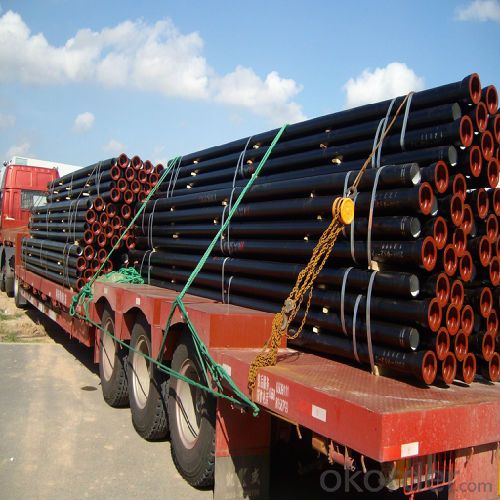
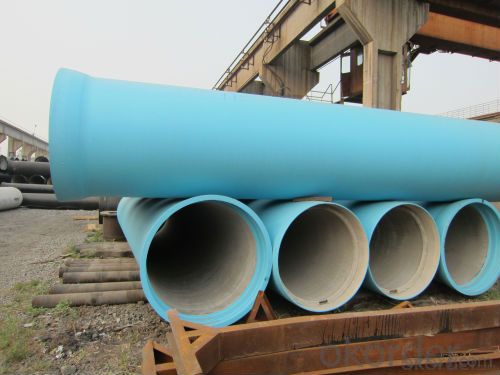
4.Ductile Iron Pipe Specification:
1) The standard of pipe: ISO2531:1998, K9
2) Effective length: 6m
3) Inner cement line: Portland cement line as per ISO4179
4) Zinc coating: at least 130g/m2 as per ISO8179
5) Bitumen painting: at least 70um as per ISO8179
6) With 100% quantity of NBR ring, or SBR ring, or EPDM ring as per ISO4633
7) DN80mm-800mm
8) High strength, lighter than grey iron, good corrosion resistance, no furring, small flow resistance, easy fixing, long life tome about 100 yeas
9) Checked by automatic inspection equipment
5.FAQ:
· Management Systems-Internal Software
· Finished Product Inventory-More Than 5000 Tons.
· Raw Material inventory -Over 8000 Mertic Tons.
· The most convenient transport and prompt delivery.
· Competitive price with best service .
· High technical production line with top quality products.
· High reputation based on best quality products.
- Q: Are ductile iron pipes susceptible to external loading or pressure?
- Yes, ductile iron pipes are susceptible to external loading or pressure. Like any other material, ductile iron pipes have a certain amount of strength and tolerance to withstand external forces. However, excessive external loading or pressure can cause deformation or failure of the pipes. It is important to ensure that ductile iron pipes are installed and supported properly to prevent any damage due to external loading. Additionally, the design and engineering of the pipeline system should take into consideration the anticipated external loading and pressure to ensure the pipes can effectively handle the expected conditions. Regular inspections and maintenance are also crucial to identify and address any issues related to external loading or pressure that may arise over time.
- Q: Can ductile iron pipes be used in agricultural applications?
- Yes, ductile iron pipes can be used in agricultural applications. Ductile iron pipes have excellent strength and durability, making them suitable for various agricultural purposes. They can be used for irrigation systems, water supply pipelines, and drainage systems in farms and agricultural fields. Ductile iron pipes are resistant to corrosion and have a long lifespan, which is crucial for agricultural applications where the pipes are exposed to various environmental factors and chemicals. Additionally, ductile iron pipes have the ability to withstand high-pressure water flow, making them ideal for transporting water for irrigation purposes. Overall, ductile iron pipes are a reliable and efficient choice for agricultural applications due to their strength, durability, corrosion resistance, and ability to handle high-pressure water flow.
- Q: How are ductile iron pipes tested for quality?
- Ductile iron pipes are tested for quality through various methods, including hydrostatic pressure testing, dimensional inspection, and mechanical properties testing. Hydrostatic pressure testing involves subjecting the pipes to water pressure to ensure they can withstand the intended operating conditions without any leakage or failure. Dimensional inspection assesses the pipes' dimensions, such as diameter, wall thickness, and length, to ensure they meet the specified standards. Mechanical properties testing evaluates the pipes' tensile strength, yield strength, and elongation to ensure they possess the necessary strength and flexibility. Overall, these rigorous testing procedures help ensure the high quality and reliability of ductile iron pipes.
- Q: Can ductile iron pipes be used for trenchless installation methods?
- Yes, ductile iron pipes can be used for trenchless installation methods. Trenchless installation methods are techniques used to install underground pipes without the need for extensive digging or trenching. Ductile iron pipes are a strong and durable choice for these methods due to their high tensile strength and flexibility. They can be installed using various trenchless techniques such as horizontal directional drilling (HDD), pipe bursting, and slip lining. These methods allow for efficient and cost-effective installation of ductile iron pipes without disrupting the surrounding environment. Additionally, the corrosion resistance of ductile iron pipes makes them suitable for trenchless installations in various soil conditions and environments.
- Q: Can ductile iron pipes be used for irrigation of sports fields?
- Yes, ductile iron pipes can be used for irrigation of sports fields. Ductile iron pipes are known for their durability, strength, and corrosion resistance, making them suitable for various applications, including irrigation. They can effectively transport water over long distances and withstand the pressure required for irrigation systems. Additionally, ductile iron pipes have a long lifespan, reducing the need for frequent replacements and ensuring reliable irrigation for sports fields.
- Q: Can ductile iron pipes be used in areas with high groundwater levels?
- Yes, ductile iron pipes can be used in areas with high groundwater levels. Ductile iron pipes are known for their strength, durability, and resistance to corrosion, making them suitable for various applications, including water supply systems. They can withstand high groundwater levels without compromising their structural integrity. Additionally, ductile iron pipes have a smooth interior surface, which helps in maintaining the flow capacity and reducing the risk of clogging or sediment buildup. Therefore, they are a reliable choice for areas with high groundwater levels, providing a long-lasting and efficient solution for water distribution systems.
- Q: Is ductile iron pipe breakable?
- 5, inferior wood surface is easy to produce cracks, because its billet is adobe, Adobe porous, Adobe in the process of cooling due to the role of thermal stress, cracks, after rolling, there are cracks;6, poor drainage tube appearance often pitted phenomenon. Pits is due to groove wear caused by defects in pipe surface irregular uneven. Because of the poor sewer pipe manufacturers to pursue profits, often rolling groove rolling most standard.Ductile iron pipes are broken because of the excessive heat treatment during casting or the lack of proper addition in casting to prevent a change in the proper brittleness and to cause cracking. It is recommended that you used to repair defects of cast iron machine, are currently on the market to sell, but also can ensure welding intact appearance, make your products by quality, but if it is in the use of performance can not meet the effect, especially the pipeline pressure quite big, what methods are of no use that must be re cast as the new.
- Q: Can ductile iron pipes be used for underground wastewater outfalls?
- Yes, ductile iron pipes can be used for underground wastewater outfalls. Ductile iron is a strong and durable material that can withstand the harsh conditions of underground installations, making it suitable for transporting wastewater efficiently and reliably.
- Q: What are the differences between cast iron pipes W and A?
- Cast iron drainage pipe generally divided into three categories, namely W type socket cast iron pipes, cast iron pipes of A type, B type cast iron drainage pipe, the three pipes have good seismic performance, strong sealing performance, simple construction, convenient maintenance, reliable use, so it is also called the cast iron pipe for earthquake.
- Q: What is the typical lifespan of ductile iron pipes?
- The typical lifespan of ductile iron pipes can vary depending on various factors such as the quality of the pipes, the environmental conditions, and the maintenance practices. However, on average, ductile iron pipes have a lifespan of around 75 to 100 years. This makes them a durable and long-lasting option for water and sewage transportation systems. With proper installation and regular maintenance, these pipes can withstand corrosion, pressure, and other external factors, ensuring their longevity and reliability. Additionally, advancements in coatings and linings have further enhanced the lifespan of ductile iron pipes, making them an excellent choice for infrastructural projects.
Send your message to us
Ductile Iron Pipe EN545/EN598 DN800 High Quality
- Loading Port:
- China main port
- Payment Terms:
- TT or LC
- Min Order Qty:
- 1000 m
- Supply Capability:
- 500000 m/month
OKorder Service Pledge
OKorder Financial Service
Similar products
Hot products
Hot Searches
Related keywords
